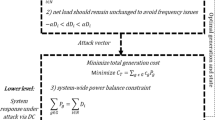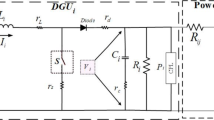Abstract
Cyber-attacks on smart-grid systems have become increasingly more complicated, and there is a need for taking detection and mitigation measures to combat their adverse effects on the smart-grid infrastructure. Wide area measurement system (WAMS) infrastructure comprising of phasor measurement units (PMUs) has recently shown remarkable progress in solving complex power system problems and avoiding blackouts. However, WAMS is vulnerable to cyber-attacks. This paper presents a novel cyber-attack resilient WAMS framework incorporating both attack detection and mitigation modules that ensure the resiliency of PMU data-based supervisory protection applications. It includes deep learning-based Long Short Term Memory (LSTM) model for real-time detection of anomalies in time-series PMU measurements and isolating the compromised PMUs followed by Generative Adversarial Imputation Nets (GAIN) for the reconstruction of the compromised PMU’s data. The corrected PDC data-stream is then forwarded to the decision-making end application, making it resilient against attacks. A Random Forrest classifier is used in the end application to distinguish fault events from other disturbances and supervise the third zone of distance relay for backup protection of transmission lines. The efficacy of the proposed framework for different attack scenarios has been verified on the WSCC 9-Bus System modeled on a developed real-time digital simulator (RTDS)-based integrated cyber-physical WAMS testbed. Experimental analysis shows that the proposed model successfully detects and mitigates attacks’ adverse effects on the end application.












Similar content being viewed by others
Explore related subjects
Discover the latest articles and news from researchers in related subjects, suggested using machine learning.References
Phadke AG, Bi T (2018) Phasor measurement units, WAMS, and their applications in protection and control of power systems. J Modern Power Syst Clean Energy 6(4):619–629
Brahma S, Kavasseri R, Cao H, Chaudhuri N, Alexopoulos T, Cui Y (2016) Real-time identification of dynamic events in power systems using pmu data, and potential applications–models, promises, and challenges. IEEE Trans Power Deliv 32(1):294–301
Bernabeu EE, Thorp JS, Centeno V (2011) Methodology for a security/dependability adaptive protection scheme based on data mining. IEEE Trans Power Deliv 27(1):104–111
Tan J, Crossley P, McLaren P, Gale P, Hall I, Farrell J (2002) Application of a wide area backup protection expert system to prevent cascading outages. IEEE Trans Power Deliv 17(2):375–380
Biswal M, Brahma SM, Cao H (2016) Supervisory protection and automated event diagnosis using pmu data. IEEE Trans Power Deliv 31(4):1855–1863
Seethalekshmi K, Singh SN, Srivastava SC (2012) A classification approach using support vector machines to prevent distance relay maloperation under power swing and voltage instability. IEEE Trans Power Deliv 27(3):1124–1133
Jena MK, Samantaray SR, Panigrahi BK (2017) A new decentralized approach to wide-area back-up protection of transmission lines. IEEE Syst J 12(4):3161–3168
Das S, Panigrahi BK (2018) Real-time secured third zone relay operation under dynamic stressed conditions. IEEE Syst J 13(3):3337–3346
Samantaray S, Sharma A et al (2018) Enhancing performance of wide-area back-up protection scheme using pmu assisted dynamic state estimator. IEEE Trans Smart Grid 10(5):5066–5074
Khan R, McLaughlin K, Laverty JHD, David H, Sezer S (2018) Demonstrating cyber-physical attacks and defense for synchrophasor technology in smart grid, In: 2018 16th Annual Conference on Privacy, Security and Trust (PST). IEEE, 2018, pp. 1–10
Almas MS, Vanfretti L, Singh RS, Jonsdottir GM (2017) Vulnerability of synchrophasor-based WAMPAC applications’ to time synchronization spoofing. IEEE Trans Smart Grid 9(5):4601–4612
Chawla A, Agrawal P, Singh A, Panigrahi BK, Paul K, Bhalja B (2020) Denial-of-service resilient frameworks for synchrophasor-based wide area monitoring systems. Computer 53(5):14–24
Initiative NAS et al. (2015) Naspi 2014 survey of synchrophasor system networks-results and findings, North American SynchroPhasor Initiative (NASPI)
Martin K, Brunello G, Adamiak M, Antonova G, Begovic M, Benmouyal G, Bui P, Falk H, Gharpure V, Goldstein A et al (2014) An overview of the IEEE standard C37.118.2—synchrophasor data transfer for power systems. IEEE Trans Smart Grid 5(4):1980–1984
Case DU (2016) Analysis of the cyber attack on the ukrainian power grid, Electricity Information Sharing and Analysis Center (E-ISAC), vol. 388
Ashok A, Govindarasu M, Ajjarapu V (2016) Online detection of stealthy false data injection attacks in power system state estimation. IEEE Trans Smart Grid 9(3):1636–1646
Sridhar S, Govindarasu M (2014) Model-based attack detection and mitigation for automatic generation control. IEEE Trans Smart Grid 5(2):580–591
James J, Hou Y, Li VO (2018) Online false data injection attack detection with wavelet transform and deep neural networks. IEEE Trans Ind Inf 14(7):3271–3280
Ghafouri M, Au M, Kassouf M, Debbabi M, Assi C, Yan J (2020) Detection and mitigation of cyber attacks on voltage stability monitoring of smart grids. IEEE Trans Smart Grid 11(6):5227–5238
Chakhchoukh Y, Lei H, Johnson BK (2019) Diagnosis of outliers and cyber attacks in dynamic pmu-based power state estimation. IEEE Trans Power Syst 35(2):1188–1197
Wang J, Shi D, Li Y, Chen J, Ding H, Duan X (2018) Distributed framework for detecting pmu data manipulation attacks with deep autoencoders. IEEE Trans Smart Grid 10(4):4401–4410
Pal S, Sikdar B, Chow JH (2017) Classification and detection of pmu data manipulation attacks using transmission line parameters. IEEE Trans Smart Grid 9(5):5057–5066
Musleh AS, Khalid HM, Muyeen S, Al-Durra A (2017) A prediction algorithm to enhance grid resilience toward cyber attacks in wamcs applications. IEEE Syst J 13(1):710–719
Khalid HM, Peng JC-H (2016) A bayesian algorithm to enhance the resilience of WAMS applications against cyber attacks. IEEE Trans Smart Grid 7(4):2026–2037
Cameron C, Patsios C, Taylor PC, Pourmirza Z (2018) Using self-organizing architectures to mitigate the impacts of denial-of-service attacks on voltage control schemes. IEEE Trans Smart Grid 10(3):3010–3019
Siami-Namini S, Tavakoli N, Namin AS (2018) A comparison of ARIMA and LSTM in forecasting time series. In: 2018 17th IEEE international conference on machine learning and applications (ICMLA). IEEE, pp 1394–1401
Wang G-G, Lu M, Dong Y-Q, Zhao X-J (2016) Self-adaptive extreme learning machine. Neural Comput Appl 27(2):291–303
Hochreiter S, Schmidhuber J (1997) Long short-term memory. Neural Comput 9(8):1735–1780
Gers FA, Schmidhuber J, Cummins F (1999) Learning to forget: continual prediction with LSTM. In: Ninth international conference on artificial neural networks ICANN 99. pp 850–855
García-Laencina PJ, Sancho-Gómez J-L, Figueiras-Vidal AR (2010) Pattern classification with missing data: a review. Neural Comput Appl 19(2):263–282
Yoon J, Jordon J, Schaar M (2018) GAIN: missing data imputation using generative adversarial nets. In: International conference on machine learning, PMLR. pp 5689–5698
Goodfellow IJ, Pouget-Abadie J, Mirza M, Xu B, Warde-Farley D, Ozair S, Courville A, Bengio Y (2014) Generative adversarial networks, arXiv preprint arXiv:1406.2661
Horowitz SH, Phadke AG (2006) Third zone revisited. IEEE Trans Power Deliv 21(1):23–29
Phadke AG, Thorp JS (2010) Communication needs for wide area measurement applications, In: 2010 5th International Conference on Critical Infrastructure (CRIS), 2010, pp. 1–7
Wang G-G, Deb S, Cui Z (2019) Monarch butterfly optimization. Neural Comput Appl 31(7):1995–2014
Heidari AA, Mirjalili S, Faris H, Aljarah I, Mafarja M, Chen H (2019) Harris hawks optimization: algorithm and applications. Future Gen Comput Syst 97:849–872
Li J, Lei H, Alavi AH, Wang G-G (2020) Elephant herding optimization: variants, hybrids, and applications. Mathematics 8(9):1415
Acknowledgements
Funding for this project was provided by the Ministry of Science and Technology, Department of Science and Technology, India, under project S3RACPPS (Research and development of Smart, Secure, Scalable, Resilient and Adaptive Cyber-Physical Power System) with grant number RP03609.
Author information
Authors and Affiliations
Corresponding author
Ethics declarations
Conflict of interest
The authors declare that they have no conflict of interest.
Additional information
Publisher's Note
Springer Nature remains neutral with regard to jurisdictional claims in published maps and institutional affiliations.
Rights and permissions
About this article
Cite this article
Chawla, A., Agrawal, P., Panigrahi, B.K. et al. Deep-learning-based data-manipulation attack resilient supervisory backup protection of transmission lines. Neural Comput & Applic 35, 4835–4854 (2023). https://doi.org/10.1007/s00521-021-06106-3
Received:
Accepted:
Published:
Issue Date:
DOI: https://doi.org/10.1007/s00521-021-06106-3




